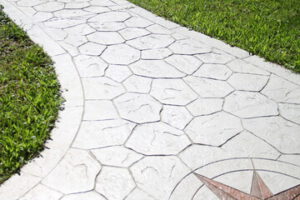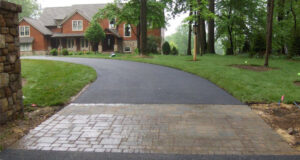Stamped concrete is a versatile and affordable paving solution. It is slip-resistant and comes in a wide range of color options. It is also durable and resists weather elements, such as rain, sunlight, freezing, and thawing.
It is often used to imitate tile, stone, brick, and cobblestone for patios, pool decks, and interior floors. However, it’s not the best choice for driveways and parking lots.
The cost of stamped concrete varies from project to project and is affected by the size and complexity of the design. A simple square or rectangular design will cost less than a curved driveway or pool deck, which requires specialized forms and labor. Additionally, the more complex the pattern, the more expensive it will be to install. In some cases, it is more cost-effective to hire a professional contractor to ensure that the stamped concrete is installed correctly.
Before the stamping process begins, the contractor must prepare the site and remove any existing material like asphalt or pavers. A base of gravel and crushed rock should be laid and compacted to provide a solid foundation for the new concrete slab. This is essential to reduce the amount of time and money that would be required to repair the surface later on.
Once the concrete is poured, it must be allowed to set before the contractor can begin the stamping process. Depending on the concrete mix used, this could take up to three days. It is important to choose a quality mix that will provide strength and durability. In addition, a concrete sealer is often applied to the finished product. This protects the concrete from stains and helps it retain its color for longer.
After the stamped concrete is dry, it must be broom-swept and washed to remove any dirt or debris that has accumulated on its surface. Sweeping or hosing the concrete regularly will prevent everyday grime from building up and causing lasting damage to the surface. In addition, a diluted liquid cleaner can be used to remove stubborn stains from the concrete surface.
In addition to regular maintenance, it is also important to keep the surface clear of ice and snow. Freezing and thawing can damage the stamped concrete, causing cracks that are hard to repair. It is also recommended to use deicing salts sparingly, as they can eat away at the concrete.
While stamped concrete is a more expensive option than other types of paving materials, it offers many advantages including longevity, durability, and versatility. It is a great choice for homeowners who want to add value to their property and improve its curb appeal. In addition to its attractive appearance, it is easy to maintain and can be customized with different colors and textures.
Durability
With the right care, stamped concrete can last a long time and look great. It’s also much more affordable than pavers, bricks, or stone patios. But it’s important to keep in mind that concrete is prone to cracking, so you should plan accordingly. If you are concerned about it, you should consider hiring a professional to repair any cracks in the concrete or replace it.
Stamped concrete is concrete that is patterned, textured, or imprinted to resemble brick, slate, flagstone, cobblestone, tile, wood, or various other natural materials. It can also be colored to match your other landscaping features. While this method is less expensive and simpler than installing paving stones or pavers, it’s not as durable. In addition, it can be damaged by harsh weather conditions and requires regular maintenance.
The durability of stamped concrete depends on the type of cement used, the amount of reinforcement included, and the finishing techniques. The best way to ensure a long-lasting, beautiful finish is to use a high-quality commercial grade concrete. It’s also a good idea to hire a licensed and insured contractor to complete the project.
A color hardener is added to the concrete prior to stamping to achieve the desired finish. Its purpose is to provide an attractive, consistent coloring. It can also be mixed with stains to create a unique color and texture. The color hardener can also be applied in a contrasting layer to the concrete’s surface.
After the color hardener has been added, the concrete is ready for stamping and textured skin application. It’s important to note that this step is best done when the sun and shade are at equal parts of the work area. This will help reduce the effects of temperature changes and sun exposure on the concrete’s drying time.
Next, a powered release agent is added to the concrete surface. This product serves two purposes: it imparts a fine, textured color to the concrete and acts as a bond breaker. It also prevents the stamping mats and textured skins from sticking to the concrete and disturbing the imprint texture.
Maintenance
Stamped concrete is an excellent option for patios, walkways and driveways. It is aesthetically pleasing, durable and easy to maintain. It can even add to your property resale value. However, it is important to understand that like any other outdoor surface, it will require some maintenance in order to look its best.
The first step is to clean the surface regularly. A basic cleaning with a garden hose, soap and brush works well. It is also a good idea to power wash the surface when necessary, especially if you live in an area with high rainfall or a lot of dust and dirt. Just be careful not to blast the surface with 2,000-psi water jets, as this can damage or fade the decorative concrete.
A good sealer will help protect the surface and keep it looking fresh. It can also help the concrete resist damage from freeze/thaw cycles, expansion and buckling, as well as de-icing chemicals and stains. However, be sure to choose a sealant that does not make the concrete too slippery when wet. It is also a good idea to remove any items that are permanently placed on the concrete such as pots, planters and other containers.
Stain removal is relatively simple, although it is important to get to any spills or splatters as soon as possible. A diluted liquid cleaner or a solvent like xylene can be used to break up tough stains. If a stain is allowed to sit for long periods of time, it may become permanent.
Keeping up with routine cleaning and sealing is the best way to prolong the life of your stamped concrete. However, if you are not comfortable with the maintenance yourself, a professional can help you keep your backyard beautiful and safe.
One of the biggest threats to stamped concrete is de-icing salts, which can eat away at the surface. This is especially common in areas that receive drip-off from parked cars. Try to avoid laying down de-icing products on your stamped concrete, and try to park your car away from the concrete. If this is not practical, be sure to use concrete-safe ice melt products that contain sand or sawdust rather than salt.
Safety
Concrete is a great material for reducing fire hazards around homes, such as outdoor kitchens and grilling areas. It is durable and heat-resistant, so it can withstand the flames from combustible cooking equipment without being damaged. However, it must be properly maintained to prevent accidents and keep guests safe. One way to do this is to apply a stamped overlay to the surface. This will protect the concrete from combustible items while adding an attractive texture to your backyard.
Before you start stamping work on the concrete, it is important to make sure that the plasticity has reached the right stage. If you begin to stamp before it is ready, the concrete will not have enough strength to support the weight of workers or hold a clear imprint. You can check the plasticity by using a concrete slump test or wet-cement strength index (SCSI).
It is also important to use a powdered release agent on the stamp mats before applying them. This will create extra bond-breaking to help ensure a clean imprint and help the color to shine through. It is also advisable to use a random pattern on the stamped concrete, rather than repeating the same pattern over and over. This looks more natural and authentic.
Depending on the type of finish that you choose for your concrete, you may need to wash it periodically with a pressure washer. This can be done without damaging the concrete, provided that you use a low setting and avoid direct contact with the surface. A good choice for cleaning stamped concrete is a mild soap and water.
In addition to washing the concrete, you should regularly sweep it to remove any debris that can damage the surface. It is also a good idea to apply a sealant on your concrete surface. This will protect it from stains and other damage, especially during winter when ice melts and de-icing salts can cause the concrete to stain or erode.
It is also a good idea to ask your contractor about the best sealant for your concrete. Be sure to choose a high-quality product that will last for as long as possible. Generally, it is recommended that you re-seal your concrete every 2-3 years.


